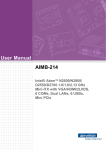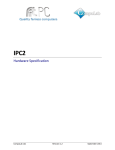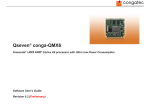Download conga-QEVAL User's Guide
Transcript
User Manual Qseven™ conga-QEVAL Detailed description of the congatec Qseven™ evaluation carrier board Version September 2009 Data Modul AG - www.data-modul.com Revision History Revision Date (dd.mm.yy) Author 1.0 1.1 23.03.09 08.09.09 GDA GDA Changes Official release Removed description for socket CN44. SD/MMC PLUS is not supported on the conga-QEVAL. Added note about USB Client connector in section 4.2.5. Preface This user's guide provides information about the components, features and connectors available on the conga-QEVAL Qseven™ evaluation carrier board. Disclaimer The information contained within this user’s guide, including but not limited to any product specification, is subject to change without notice. congatec AG provides no warranty with regard to this user’s guide or any other information contained herein and hereby expressly disclaims any implied warranties of merchantability or fitness for any particular purpose with regard to any of the foregoing. congatec AG assumes no liability for any damages incurred directly or indirectly from any technical or typographical errors or omissions contained herein or for discrepancies between the product and the user’s guide. In no event shall congatec AG be liable for any incidental, consequential, special, or exemplary damages, whether based on tort, contract or otherwise, arising out of or in connection with this user’s guide or any other information contained herein or the use thereof. Intended Audience This user's guide is intended for technically qualified personnel. It is not intended for general audiences. Lead-Free Designs (RoHS) All congatec AG products are created from lead‑free components and are completely RoHS compliant. Copyright © 2009 congatec AG QEVAm11 2/36 Symbols The following symbols are used in this user's guide: Warning Warnings indicate conditions that, if not observed, can cause personal injury. Caution Cautions warn the user about how to prevent damage to hardware or loss of data. Note Notes call attention to important information that should be observed. Connector Type Describes the connector that must be used with the Qseven™ evaluation carrier board, not the connector found on the Qseven™ evaluation carrier board. Link to connector layout diagram This link icon is located in the top left corner of each page. It provides a direct link to the connector layout diagram on page 8 of this document. Copyright Notice Copyright © 2009, congatec AG. All rights reserved. All text, pictures and graphics are protected by copyrights. No copying is permitted without written permission from congatec AG. congatec AG has made every attempt to ensure that the information in this document is accurate yet the information contained within is supplied “as-is”. Copyright © 2009 congatec AG QEVAm11 3/36 Terminology Term PCI Express (PCIe) PCI Express Lane Description Peripheral Component Interface Express – next-generation high speed Serialized I/O bus One PCI Express Lane is a set of 4 signals that contains two differential lines for Transmitter and two differential lines for Receiver. Clocking information is embedded into the data stream. x1, x2, x4, x16 x1 refers to one PCI Express Lane of basic bandwidth; x2 to a collection of two PCI Express Lanes; etc.. Also referred to as x1, x2, x4 or x16 link. ExpressCard A PCMCIA standard built on the latest USB 2.0 and PCI Express buses. PCI Express Mini Card PCI Express Mini Card add-in card is a small size unique form factor optimized for mobile computing platforms. MMCplus MMCplus was defined for first time in MMC System Specification v4.0. MMCplus is backward compatible with MMC. MMCplus has 13 pins. SDIO card SDIO (Secure Digital Input Output) is a non-volatile memory card format developed for use in portable devices. USB Universal Serial Bus SATA Serial AT Attachment: serial-interface standard for hard disks HDA High Definition Audio S/PDIF S/PDIF (Sony/Philips Digital Interconnect Format) specifies a Data Link Layer protocol and choice of Physical Layer specifications for carrying digital audio signals between devices and stereo components. HDMI High Definition Multimedia Interface. HDMI supports standard, enhanced, or high-definition video, plus multi-channel digital audio on a single cable. TMDS Transition Minimized Differential Signaling. TMDS is a signaling interface defined by Silicon Image that is used for DVI and HDMI. DVI Digital Visual Interface is a video interface standard developed by the Digital Display Working Group (DDWG). LPC Low Pin-Count: a low speed interface used for peripheral circuits such as Super I/O controllers, which typically combine legacy device support into a single IC. I²C Bus Inter-Integrated Circuit Bus: is a simple two-wire bus with a software-defined protocol that was developed to provide the communications link between integrated circuits in a system. SM Bus System Management Bus: is a popular derivative of the I²C-bus. GBE Gigabit Ethernet LVDS Low-Voltage Differential Signaling SDVO Serial Digital Video Out is a proprietary technology introduced by Intel® to add additional video signaling interfaces to a system. DDC Display Data Channel is an I²C bus interface between a display and a graphics adapter. N.C. Not connected N.A. Not available T.B.D. To be determined Technical Support congatec AG technicians and engineers are committed to providing the best possible technical support for our customers so that our products can be easily used and implemented. We request that you first visit our website at www.congatec.com for the latest documentation, utilities and drivers, which have been made available to assist you. If you still require assistance after visiting our website then please contact our technical support department by email at [email protected] Copyright © 2009 congatec AG QEVAm11 4/36 Electrostatic Sensitive Device All electronic parts described in this user's guide are electrostatic sensitive devices and are packaged accordingly. Do not open or handle a carrier board or module except at an electrostatic-free workstation. Additionally, do not ship or store electronic devices near strong electrostatic, electromagnetic, magnetic, or radioactive fields unless the device is contained within its original manufacturer's packaging. Trademarks All Trademarks and Registered Trademarks used in this user’s guide, whether marked as Trademarks or not marked, are declared to belong to the owner/s. Warranty congatec AG makes no representation, warranty or guaranty, express or implied regarding the products except its standard form of limited warranty (“Limited Warranty”). congatec AG may in its sole discretion modify its Limited Warranty at any time and from time to time. Beginning on the date of shipment to its direct customer and continuing for the published warranty period, congatec AG represents that the products are new and warrants that each product failing to function properly under normal use, due to a defect in materials or workmanship or due to non conformance to the agreed upon specifications, will be repaired or exchanged, at congatec AG’s option and expense. Customer will obtain a Return Material Authorization (“RMA”) number from congatec AG prior to returning the non conforming product freight prepaid. congatec AG will pay for transporting the repaired or exchanged product to the customer. Repaired, replaced or exchanged product will be warranted for the repair warranty period in effect as of the date the repaired, exchanged or replaced product is shipped by congatec AG, or the remainder of the original warranty, whichever is longer. This Limited Warranty extends to congatec AG’s direct customer only and is not assignable or transferable. Except as set forth in writing in the Limited Warranty, congatec AG makes no performance representations, warranties, or guarantees, either express or implied, oral or written, with respect to the products, including without limitation any implied warranty (a) of merchantability, (b) of fitness for a particular purpose, or (c) arising from course of performance, course of dealing, or usage of trade. congatec AG shall in no event be liable to the end user for collateral or consequential damages of any kind. congatec AG shall not otherwise be liable for loss, damage or expense directly or indirectly arising from the use of the product or from any other cause. The sole and exclusive remedy against congatec AG, whether a claim sound in contract, warranty, tort or any other legal theory, shall be repair or replacement of the product only. Certification congatec AG is certified to DIN EN ISO 9001:2000 standard. Copyright © 2009 congatec AG QEVAm11 5/36 Contents 1 Introduction................................................................................. 7 1.1 Qseven™ Concept...................................................................... 7 2 Connector Layout........................................................................ 8 3 Specifications.............................................................................. 9 3.1 3.2 3.2.1 3.2.2 3.2.3 3.3 3.4 Mechanical Dimensions.............................................................. 9 Power Supply.............................................................................. 9 PWR_OK Signal....................................................................... 11 Power Status LEDs D30-D32 and D40-D42............................. 11 Power-up Control...................................................................... 12 CMOS Battery........................................................................... 13 Environmental Specifications.................................................... 13 4 Connector Description.............................................................. 14 4.2 4.2.1 4.2.2 4.2.3 4.2.4 4.2.5 4.2.6 4.2.7 4.2.8 4.2.8.1 4.2.8.2 4.2.8.3 4.2.9 4.2.10 4.2.10.1 4.2.10.2 4.2.11 Subsystems of conga-QEVAL................................................... 17 I²C Bus ..................................................................................... 17 HDA Audio................................................................................. 17 LPC Super I/O Device............................................................... 18 LPC Firmware Hub................................................................... 19 Universal Serial Bus (USB)....................................................... 19 Ethernet 10/100/1000............................................................... 20 Serial ATA™.............................................................................. 21 LVDS Flat Panel Interface......................................................... 21 Flat Panel and Backlight Power Supply.................................... 22 Flat Panel and Backlight Power Supply Connection................. 23 Flat Panel Configuration Data................................................... 24 PCI Express x1 Connectors...................................................... 24 ExpressCard and PCI Express Mini Card................................. 26 ExpressCard............................................................................. 26 PCI Express Mini Card.............................................................. 27 PCI Express Graphics (PEG).................................................... 28 Copyright © 2009 congatec AG 4.2.12 4.2.12.1 SDIO Interface.......................................................................... 29 SD/MMC Card Socket............................................................... 29 5 Additional Features................................................................... 30 5.1 5.2 5.3 5.4 5.5 5.6 5.7 5.8 5.9 5.10 Power Button............................................................................ 30 Sleep Button............................................................................. 30 Reset Button............................................................................. 30 LID Button................................................................................. 30 PC Speaker............................................................................... 30 Debug Display........................................................................... 31 Internal Use Only Connectors................................................... 31 Ground Probes.......................................................................... 32 Fan Connector and Power Configuration.................................. 32 Feature Connector.................................................................... 34 6 conga-QEVAL Mechanical Drawing.......................................... 35 7 Industry Specifications.............................................................. 36 QEVAm11 6/36 1 Introduction 1.1 Qseven™ Concept The Qseven™ concept is an off-the-shelf, multi vendor, Single-Board-Computer that integrates all the core components of a common PC and is mounted onto an application specific carrier board. Qseven™ modules have a standardized form factor of 70mm x 70mm and a specified pinout based on the high speed MXM system connector and the pinout remains the same regardless of the vendor. The Qseven™ module provides the functional requirements for an embedded application. These functions include, but are not limited to, graphics, sound, mass storage, network interface and multiple USB ports. A single ruggedized MXM connector provides the carrier board interface to carry all the I/O signals to and from the Qseven™ module. This MXM connector is a well known and proven high speed signal interface connector that is commonly used for high speed PCI Express graphics cards in notebooks. Carrier board designers can utilize as little or as many of the I/O interfaces as deemed necessary. The carrier board can therefore provide all the interface connectors required to attach the system to the application specific peripherals. This versatility allows the designer to create a dense and optimized package, which results in a more reliable product while simplifying system integration. The Qseven™ evaluation carrier board provides carrier board designers with a reference design platform and the opportunity to test all the Qseven™ I/O interfaces available and then choose what are suitable for their application. Qseven™ applications are scalable, which means once a carrier board has been created there is the ability to diversify the product range through the use of different performance class Qseven™ modules. Simply unplug one module and replace it with another, no need to redesign the carrier board. This document describes the features available on the Qseven evaluation carrier board. Additionally, the schematics for the Qseven™ evaluation carrier board can be found on the congatec website. Copyright © 2009 congatec AG QEVAm11 7/36 2 Connector Layout The connector layout picture below shows each connector and its name designator. Jumpers and their respective Pin 1 are also shown. Select the Adobe ‘Zoom-In-Tool’ and zoom in on a given component to see its designator. Hover over the component and the ‘Zoom-In-Tool’ will change indicating there is a link. Click on the link to navigate to the area in the document where the component is described. Use the mouse icon in the top left hand corner of the destination page to return to the connector layout picture. Copyright © 2009 congatec AG QEVAm11 8/36 3 Specifications 3.1 Mechanical Dimensions • 293.4mm x 171.5mm • Height approximately 37mm 3.2 Power Supply The conga-QEVAL can be used with standard ATX (Connector CN38) power supplies. The 3.3V, 5V and -5V power outputs of the ATX power supply are not used. ATX Power Connector (CN38) The following table lists the pinout for connector CN38. Pin Signal Description Pin Signal Description 1 2 3 4 +3.3V +3.3V GND +5V Power Supply +3.3VDC Power Supply +3.3VDC Power Ground Power Supply +5VDC 13 14 15 16 +3.3V -12V GND PS_ON# 5 6 7 8 GND +5V GND PWR_OK 17 18 19 20 GND GND GND -5V 9 10 11 12 5V_SB +12V +12V +3.3V Power Ground Power Supply +5VDC Power Ground Power Ok: A status signal generated by the power supply to notify the computer that the DC operating voltages are within the ranges required for proper computer operation. Standby Power Supply +5VDC Power Supply +12DC Power Supply +12DC Power Supply +3.3VDC Power Supply +3.3VDC Power Supply -12VDC Power Ground Power Supply On (active low). Short this pin to GND to switch power supply ON, disconnect from GND to switch OFF. Power Ground Power Ground Power Ground Power Supply -5VDC 21 22 23 24 +5V +5V +5V GND Power Supply +5VDC Power Supply +5VDC Power Supply +5VDC Power Ground Copyright © 2009 congatec AG QEVAm11 9/36 When using an ATX power supply, the Qseven™ module will start after the power-on button SW1 is pressed. The ATX power supply can also be used in AT mode. In this case the module will start after the power switch on the power supply is turned on. The power supply mode can be configured using jumper CN41. Jumper CN41 Configuration 1-2 2-3 ATX Power supply (default) ATX Power supply runs in AT mode Pwr On (SW1) Power Mode Config (CN41) 1 Connector Type 2 3 CN41 : 2.54mm grid jumper. The input voltage can be disconnected from power sources through the use of switch SW6. SW6 ON (1 - 3) OFF (2 - 3) Configuration Input power voltage is ON (default) Input power voltage is forced off SW6 1 2 3 The conga-QEVAL can also be used with +12VDC power supply (connector M5 and M6). The +3.3V and +5V used by some devices on the conga-QEVAL are generated onboard from the +12V power supply. Connector M5 M6 Configuration Ground +12VDC ±5% GND (M5) +12V (M6) Connector Type 4mm diameter plug Copyright © 2009 congatec AG QEVAm11 10/36 3.2.1 PWR_OK Signal The Qseven™ specification defines the signal PWRGIN, which is a HIGH active input from the main power supply to the module and indicates whether the power is good. Jumper CN43 on the conga-QEVAL provides the ability to choose different settings for this signal. Jumper CN43 1-2 3-4 5-6 Configuration PWGIN generated by Pull-up resistor. (default) PWGIN generated by ATX power source. PWGIN generated by DC/DC converter. PWGIN Config. (CN43) 2 4 6 1 3 5 Connector Type CN43: 2.54mm grid jumper. 3.2.2 Power Status LEDs D30-D32 and D40-D42 The six green status LEDs D30-D32 and D40-D42 indicate different power states of the conga-QEVAL. Refer to the following table for detailed information. LEDs D30-D32 and D40-D42 All Off D30 D31 D32 D40 D41 D42 Power state No power applied. +5V Standby power is present. +5V is present. +3.3V is present +12V is present +12V_IN is present +5V_SBY_IN is present Copyright © 2009 congatec AG D30-D32 D40-D42 QEVAm11 11/36 3.2.3 Power-up Control The native system Power-up support of Qseven™ modules uses the 'SUS_S3#' signal to control the 'PS_ON#' signal, which is used to switch the ATX power supply on or off. When using the SUS_S3#' signal the Qseven™ module is capable of supporting Suspend to RAM (S3). When the system goes to Suspend to RAM (S3) or Soft Off (S5), the 'SUS_S3#' signal is asserted by the chipset of the module. Through the use of an inverter, the low active 'PS_ON#' signal goes high and switches off the ATX power supply. Vice versa, if the system resides in a power-down system state, any system wake-up event invokes the chipset of the module to deassert the 'SUS_S3#' signal. This results in a system transition to Full-On (S0). The way Suspend to RAM is implemented on a Qseven™ module may differ depending on the module manufacturer. For this reason, it is recommended that a hardware jumper be implemented on the carrier board in order to provide the ability to choose if the 'PS_ON#' signal should be controlled either by the 'SUS_S3#' signal or 'SUS_S5#' signal. On the conga-QEVAL this is accomplished through the use of jumper CN48. Jumper CN48 Configuration 1-2 2-3 ATX Power supply controlled via S3# (default) ATX Power supply controlled via S5# Control signal Config (CN48) 1 Connector Type 2 3 CN48 : 2.54mm grid jumper. Copyright © 2009 congatec AG QEVAm11 12/36 3.3 CMOS Battery The conga-QEVAL includes a battery that supplies the RTC and CMOS memory of the Qseven™ module. The battery needs to provide 3V of power. The specified battery type is CR2032. It is possible to disconnect the CMOS battery using jumper CN34. Jumper CN34 Configuration 1-2 2-3 CMOS Battery Config (CN34) Normal operation, battery connected (default) Battery disconnected 1 Connector Type 2 3 CN34 : 2.54mm grid jumper. Warning Danger of explosion if battery is incorrectly replaced. Replace only with the same or equivalent type recommended by the manufacturer. Dispose of used batteries according to the manufacturer's instructions. To fulfill the requirements of the EN60950, the conga-QEVAL incorporates two current-limiting devices (resistor and diode) in the battery power supply path. 3.4 Environmental Specifications Temperature Operation: 0° to 60°C Storage: -20° to +80°C Humidity Operation: 10% to 90% Storage: 5% to 95% The above operating temperatures must be strictly adhered to at all times. Humidity specifications are for non-condensing conditions. Copyright © 2009 congatec AG QEVAm11 13/36 4 Connector Description 4.1 Connector CN1 Pinout Pin Signal 1 3 5 7 9 11 13 15 17 19 21 23 25 27 29 31 33 35 37 39 41 43 45 47 49 51 53 55 57 59 61 63 65 67 69 GND GBE_MDI3GBE_MDI3+ GBE_LINK100# GBE_MDI1GBE_MDI1+ GBE_LINK# GBE_CTREF WAKE# SUS_STAT# SLP_BTN# GND GND BATLOW# SATA0_TX+ SATA0_TXSATA_ACT# SATA0_TX+ SATA0_TXGND BIOS_DISABLE# SDIO_CD# SDIO_CMD SDIO_PWR# SDIO_DAT0 SDIO_DAT2 SDIO_DAT4 SDIO_DAT6 GND HDA_SYNC HDA_RST# HDA_BCLK HDA_SDI HDA_SDO THRM# Description Power Ground Gigabit Ethernet MDI3Gigabit Ethernet MDI3+ 100 Mbps link speed Gigabit Ethernet MDI1Gigabit Ethernet MDI1+ Gigabit Ethernet Link indicator Reference voltage for GBE External system wake event Suspend status Sleep button Power Ground Power Ground Battery low input Serial ATA Channel 0 TX+ Serial ATA Channel 0 TXSerial ATA Activity Serial ATA Channel 0 RX+ Serial ATA Channel 0 RXPower Ground BIOS Module disable SDIO Card Detect SDIO Command/Response SDIO Power Enable SDIO Data Line 0 SDIO Data Line 2 SDIO Data Line 4 SDIO Data Line 6 Power Ground HD Audio Synchronization HD Audio Codec Reset HD Audio Serial Bit Clock HD Audio Serial Data out HD Audio Serial Data In Thermal Alarm active low Copyright © 2009 congatec AG Pin Signal 2 4 6 8 10 12 14 16 18 20 22 24 26 28 30 32 34 36 38 40 42 44 46 48 50 52 54 56 58 60 62 64 66 68 70 GND GBE_MDI2GBE_MDI2+ GBE_LINK1000# GBE_MDI0GBE_MDI0+ GBE_ACT# SUS_S5# SUS_S3# PWRBTN# LID_BTN# GND PWGIN RSTBTN# SATA1_TX+ SATA1_TXGND SATA1_TX+ SATA1_TXGND SDIO_CLK SDIO_LED SDIO_WP SDIO_DAT1 SDIO_DAT3 SDIO_DAT5 SDIO_DAT7 RESERVED GND SMB_CLK SMB_DAT SMB_ALERT# I2C_CLK I2C_DAT WDTRIG# Description Power Ground Gigabit Ethernet MDI2Gigabit Ethernet MDI2+ 1000 Mbps link speed Gigabit Ethernet MDI0Gigabit Ethernet MDI0+ Gigabit Ethernet Activity indicator S5 (Soft OFF) – shutdown state S3 (Suspend to RAM) – SLP Power button LID button Power Ground Power good input Reset button input Serial ATA Channel 1 TX+ Serial ATA Channel 1 TXPower Ground Serial ATA Channel 1 TX+ Serial ATA Channel 1 TXPower Ground SDIO Clock Output SDIO LED SDIO Write Protect SDIO Data Line 1 SDIO Data Line 3 SDIO Data Line 5 SDIO Data Line 7 Power Ground SMBus Clock line SMBus Data line SMBus Alert input I2C Bus Clock I2C Bus Data Watchdog trigger signal QEVAm11 14/36 Pin Signal 71 73 75 77 79 81 83 85 87 89 91 93 95 97 99 101 103 105 107 109 111 113 115 117 119 121 123 125 127 129 131 133 135 137 139 141 143 145 147 149 THRMTRIP# GND USB7_DUSB7_D+ USB_6_7_OC# USB5_DUSB5_D+ USB_2_3_OC# USB3_DUSB3_D+ USB_CL_PRES USB1_DUSB1_D+ GND LVDS_A0+ LVDS_A0LVDS_A1+ LVDS_A1LVDS_A2+ LVDS_A2LVDS_PPEN LVDS_A3+ LVDS_A3GND LVDS_A_CLK+ LVDS_A_CLKLVDS_BLT_CTRL LVDS_DID_DAT LVDS_DID_CLK RESERVED SDVO_BCLK+ SDVO_BCLKGND SDVO_GREEN+ SDVO_GREENGND SDVO_BLUE+ SDVO_BLUEGND SDVO_RED+ Description Thermal Trip indicates an overheating condition Power Ground USB Port 7 Differential PairUSB Port 7 Differential Pair+ Over current detect input 6/7 USB USB Port 5 Differential PairUSB Port 5 Differential Pair+ Over current detect input 2/3 USB USB Port 3 Differential PairUSB Port 3 Differential Pair+ USB Client present detect pin USB Port 1 Differential PairUSB Port 1 Differential Pair+ Power Ground LVDS Primary channel 0+ LVDS Primary channel 0LVDS Primary channel 1+ LVDS Primary channel 1LVDS Primary channel 2+ LVDS Primary channel 2LVDS Power enable LVDS Primary channel 3+ LVDS Primary channel 3Power Ground LVDS_A_CLK+ LVDS_A_CLKPWM Backlight brightness DDC Display ID Data line DDC Display ID Clock line SDVO Clock line+ SDVO Clock linePower Ground SDVO Green line+ SDVO Green linePower Ground SDVO Blue line+ SDVO Blue linePower Ground SDVO Red line+ Copyright © 2009 congatec AG Pin Signal 72 74 76 78 80 82 84 86 88 90 92 94 96 98 100 102 104 106 108 110 112 114 116 118 120 122 124 126 128 130 132 134 136 138 140 142 144 146 148 150 WDOUT GND USB6_DUSB6_D+ USB_4_5_OC# USB4_DUSB4_D+ USB_0_1_OC# USB2_DUSB2_D+ RESERVED USB0_DUSB0_D+ GND LVDS_B0+ LVDS_B0LVDS_B1+ LVDS_B1LVDS_B2+ LVDS_B2LVDS_BPEN LVDS_B3+ LVDS_B3GND LVDS_A_CLK+ LVDS_A_CLKRESERVED LVDS_BLC_DAT LVDS_BLC_CLK RESERVED SDVO_INT+ SDVO_INTGND SDVO_FLDINSTALL+ SDVO_FLDINSTALLGND SDVO_TVCLKIN+ SDVO_TVCLKINGND SDVO_CTRL_DAT Description Watchdog event indicator Power Ground USB Port 6 Differential PairUSB Port 6 Differential Pair+ Over current detect input 4/5 USB USB Port 4 Differential PairUSB Port 4 Differential Pair+ Over current detect input 0/1 USB USB Port 2 Differential PairUSB Port 2 Differential Pair+ USB Port 0 Differential PairUSB Port 0 Differential Pair+ Power Ground LVDS Secondary channel 0+ LVDS Secondary channel 0LVDS Secondary channel 1+ LVDS Secondary channel 1LVDS Secondary channel 2+ LVDS Secondary channel 2LVDS Backlight enable LVDS Secondary channel 3+ LVDS Secondary channel 3Power Ground LVDS_A_CLK+ LVDS_A_CLKSSC clock chip data line SSC clock chip clock line SDVO Interrupt line+ SDVO Interrupt linePower Ground SDVO Field stall line+ SDVO Field stall linePower Ground SDVO TV-Out line+ SDVO TV-Out linePower Ground I2C based control clock for SDVO QEVAm11 15/36 Pin Signal 151 153 155 157 159 161 163 165 167 169 171 173 175 177 179 181 183 185 187 189 191 193 195 197 199 201 203 205 207 209 211 213 215 217 219 221 223 225 227 229 SDVO_REDHDMI_HPD# PCIE_CLK_REF+ PCIE_CLK_REFGND PCIE3_TX+ PCIE3_TXGND PCIE2_TX+ PCIE2_TXEXCD0_PERST# PCIE1_TX+ PCIE1_TXEXCD0_CPPE# PCIE0_TX+ PCIE0_TXGND LPC_AD0 LPC_AD2 LPC_CLK SERIRQ +V3_RTC FAN_TACHOIN GND RESERVED RESERVED RESERVED VCC_5V_SB1 Q7_MFG0 Q7_MFG1 +V5 +V5 +V5 +V5 +V5 +V5 +V5 +V5 +V5 +V5 Description SDVO Red lineHot plug detection for HDMI PCI Express Reference Clock+ PCI Express Reference ClockPower Ground PCI Express Channel 3 Output+ PCI Express Channel 3 OutputPower Ground PCI Express Channel 2 Output+ PCI Express Channel 2 OutputExpress Card slot#0 reset PCI Express Channel 1 Output+ PCI Express Channel 1 OutputExpress Card slot#0 Capable/Req PCI Express Channel 0 Output+ PCI Express Channel 0 OutputPower Ground LPC Interface Address/Data 0 LPC Interface Address/Data 0 LPC Interface Clock Serialized interrupt 3V backup cell input Fan tachometer input Power Ground +5VDC,Standby ±5% Do not connect on carrier board Do not connect on carrier board Power supply +5VDC ±5% Power supply +5VDC ±5% Power supply +5VDC ±5% Power supply +5VDC ±5% Power supply +5VDC ±5% Power supply +5VDC ±5% Power supply +5VDC ±5% Power supply +5VDC ±5% Power supply +5VDC ±5% Power supply +5VDC ±5% Copyright © 2009 congatec AG Pin Signal 152 154 156 158 160 162 164 166 168 170 172 174 176 178 180 182 184 186 188 190 192 194 196 198 200 202 204 206 208 210 212 214 216 218 220 222 224 226 228 230 SDVO_CTRL_CLK DP_HPD# PCIE_WAKE# PCIE_RST# GND PCIE3_RX+ PCIE3_RXGND PCIE2_RX+ PCIE2_RXEXCD1_PERST# PCIE1_RX+ PCIE1_RXEXCD1_CPPE# PCIE0_RX+ PCIE0_RXGND LPC_AD1 LPC_AD3 LPC_FRAME# LPC_LDRQ# SPKR FAN_PWMOUT GND RESERVED RESERVED RESERVED VCC_5V_SB2 Q7_MFG0 Q7_MFG1 +V5 +V5 +V5 +V5 +V5 +V5 +V5 +V5 +V5 +V5 Description I2C based control data for SDVO Hot plug detection for Display port PCI Express Wake event Reset Signal for external devices Power Ground PCI Express Channel 3 Input+ PCI Express Channel 3 InputPower Ground PCI Express Channel 2 Input+ PCI Express Channel 2 InputExpress Card slot#1 reset PCI Express Channel 1 Input+ PCI Express Channel 1 InputExpress Card slot#0 Capable/Req PCI Express Channel 0 Input+ PCI Express Channel 0 InputPower Ground LPC Interface Address/Data 1 LPC Interface Address/Data 3 LPC frame indicator LPC DMA request Output for audio enunciator Fan speed control (PWM) Power Ground +5VDC Standby ±5% Do not connect on carrier board Do not connect on carrier board Power supply +5VDC ±5% Power supply +5VDC ±5% Power supply +5VDC ±5% Power supply +5VDC ±5% Power supply +5VDC ±5% Power supply +5VDC ±5% Power supply +5VDC ±5% Power supply +5VDC ±5% Power supply +5VDC ±5% Power supply +5VDC ±5% QEVAm11 16/36 4.2 Subsystems of conga-QEVAL 4.2.1 I²C Bus The I²C signals are available in different locations on the conga-QEVAL including the feature connector (CN35) described in section 5.10 of this document. Additionally, the conga-QEVAL includes a socket for an I²C EEPROM (CN29) that can be used for test purposes during the system development. This 8 pin DIP socket can be used with different 2-wire serial EEPROMS (for example 24C04 / 08 / 16 ...) and can be accessed easily by using the I²C control commands implemented in the Qseven™ EASI API driver. Refer to the Qseven™ module's user's guide and the EASI programmers guide for details. CN29 4.2.2 EEPROM Socket HDA Audio The conga-QEVAL has an HDA (High Definition Audio) codec (Realtek ALC888) mounted on it. The stereo audio output interface of this codec is available on the connector described below. The drivers for this codec can be found on the congatec website at www.congatec.com in the ‘Drivers’ section under ‘conga-QEVAL’. Stereo Jack 1 Signal Stereo Jack 2 Signal Tip Line Output Left Ring Line Output Right Sleeve Ground Stereo Jack 2 Stereo Mode Tip Microphone Input Left Ring Microphone Input Right Sleeve Analog Ground Tip Ring Sleeve Line Input Left Line Input Right Ground Audio (CN24) 1 2 3 (front view) Connector Type CN24: triple 3.5mm stereo plug Copyright © 2009 congatec AG QEVAm11 17/36 CD IN connector CN26 Pin Signal 1 2 3 4 CD-IN CN26 CD Input Left Analog Ground Analog Ground CD Input Right 1 2 3 4 S/PDIF I/O connector CN23 Pin Signal 1 2 3 4 5 6 +5V Power supply Analog Ground S/PDIF Output Analog Ground S/PDIF Input Analog Ground23 S/PDIF I/O CN23 2 4 6 1 3 5 Connector Type CN26 4 pin, 2.54mm grid female, CN23 6 pin, 2 row 2.54mm grid female 4.2.3 LPC Super I/O Device The conga-QEVAL utilizes a Super I/O controller that provides additional interfaces such as two serial ports via connector CN27. The Winbond W83627DHG controller is connected to the LPC Bus of the Qseven module. Serial ports COM1 and COM2 follow the RS232 standard. Pin COM1 COM2 DCD# RXD TXD DTR# GND DSR RTS# CTS# RI# Connector Type COM Ports CN27 1 5 6 9 The Super I/O controller can be configured using the SW5 dip switch. SW5 can be used to either disable the Super I/O or configure its base address. The following table describes the settings for SW5. Dips Configuration 1 ON/OFF 2 3 ON 4 OFF 3 OFF 4 ON Super I/O Enabled/Disabled (ON=default) N.C. Super I/O configured for address 4Eh Super I/O configured for address 2Eh (default) SW5 ON DCD# RXD TXD DTR# GND DSR RTS# CTS# RI# 1 2 3 4 1 2 3 4 5 6 7 8 9 CN27 2x 9 pin D-SUB female Copyright © 2009 congatec AG QEVAm11 18/36 4.2.4 LPC Firmware Hub The conga-QEVAL offers the possibility to boot the Qseven™ CPU module from an external firmware hub. This can be very useful when a customized BIOS must be evaluated. The evaluation carrier board includes one 32-lead PLCC socket for one LPC firmware hub (socket CN30). With jumper CN31, the user can configure whether the Qseven™ module should boot from its onboard BIOS or from a BIOS located in the external firmware hub. The yellow LED D23 is lit when the Qseven™ module boots from the external firmware hub. Jumper CN31 Configuration 1-2 2-3 Boot Config (CN31) Qseven™ module boots from external FWH (CN30) Qseven™ module boots from onboard FWH (default) S1 PLCC Socket D23 1 Connector Type 2 3 CN31: 2.54mm grid jumper 4.2.5 Universal Serial Bus (USB) The conga-QEVAL provides 6 USB ports (USB Ports 0-5) via connectors CN21 and CN22. USB Ports 4 and 5 found on connector CN22 are supplied by suspend power and can be used to test “wake-up via USB” functionality. Connector CN20 (USB B type) can be used for USB client connection. CN20 utilizes USB Port 1. USB connector pinout Pin Signal 1 2 3 4 +5V DATADATA+ GND USB Port 0 USB Client (CN20) USB Port 1 8765432 1 USB Port 2 USB Port 4 USB Port 3 Note CN22 CN21 (front view) USB Port 5 (front view) If USB Client connector CN20 is enabled within the Qseven module’s BIOS setup program, then the USB Port 1 connector (CN21) is not available. Copyright © 2009 congatec AG QEVAm11 19/36 4.2.6 Ethernet 10/100/1000 The conga-QEVAL provides a LAN interface via connector CN22. The following tables describe the pinout and configuration possibilities. RJ45 socket pinout Pin 1 3 5 7 Signal Bidirectional pair A+ Bidirectional pair B+ Bidirectional pair CBidirectional pair D+ Pin 2 4 6 8 Signal Bidirectional pair ABidirectional pair C+ Bidirectional pair BBidirectional pair D+ CN22 RJ45 Socket LED descriptions 8765432 1 LED Left Side Description Off Green Orange 10 Mbps link speed 100 Mbps link speed 1000 Mbps link speed LED Right Side Off Steady On Blinking (front view) Description No link Link established, no activity detected Link established, activity detected Jumper CN47 provides the ability to select the power source for the LAN controller. Jumper CN47 Description 1-2 2-3 LAN controller is powered from standby voltage (default) LAN controller is powered from main voltage LAN Power Source Config (CN47) 1 2 3 Connector Type 8 pin RJ45 plug CN47: 2.54mm grid jumper Copyright © 2009 congatec AG QEVAm11 20/36 4.2.7 Serial ATA™ The conga-QEVAL provides two SATA drive connectors, CN17 and CN19. The yellow LED D11 indicates when there is activity on either of the SATA interfaces. The following table describes the pinout of the SATA connectors. Pin Signal 1 2 3 4 5 6 7 4.2.8 SATA1 (CN17) GND TX+ TXGND RXRX+ GND SATA0 (CN19) 1 2 3 4 5 6 7 1 2 3 4 5 6 7 D11 Serial ATA Channel 0 Serial ATA Channel 1 LVDS Flat Panel Interface Pin LVDS Output 1 3 LVDS_DID_DAT N.C. Description DisplayID DDC data line used for LVDS flat panel detection. 2 4 Pin LVDS Output LVDS_DID_CLK DisplayID DDC clock line used for LVDS flat panel detection. N.C. Description 5 7 9 11 13 GND LVDS_A0+ LVDS_A1LVDS_BLEN LVDS_A2- Power Ground LVDS Channel A differential pairs LVDS Channel A differential pairs Controls backlight enable. (see jumper CN14) LVDS Channel A differential pairs 6 8 10 12 14 LVDS_A0LVDS_PPEN LVDS_A1+ LVDS_A2+ N.C. LVDS Channel A differential pairs Controls panel power enable LVDS Channel A differential pairs LVDS Channel A differential pairs 15 17 LVDS_A_CLKN.C. LVDS Channel A differential clock 16 18 LVDS_A_CLK+ LVDS_A3+ LVDS Channel A differential clock LVDS Channel A differential pairs 19 LVDS_A3- LVDS Channel A differential pairs 20 GND 21 23 25 27 29 31 LVDS_B0GND LVDS_B1+ LVDS_B2GND LVDS_B_CLK- LVDS Channel B differential pairs Power Ground LVDS Channel B differential pairs LVDS Channel B differential pairs Power Ground LVDS Channel B differential clock 22 24 26 28 30 32 LVDS_B0+ LVDS_B1GND LVDS_B2+ LVDS_B_CLK+ N.C. LVDS Channel B differential pairs LVDS Channel B differential pairs Power Ground LVDS Channel B differential pairs LVDS Channel B differential clock 33 LVDS_B3+ LVDS Channel B differential pairs 34 LVDS_B3- LVDS Channel B differential pairs Connector Type LVDS (CN12) X13: 34 pin, 2 row 2mm grid female. 2 1 4 3 6 5 8 7 10 12 14 16 9 11 13 15 Copyright © 2009 congatec AG 18 20 17 19 22 24 26 28 30 21 23 25 27 29 32 34 31 33 QEVAm11 21/36 The polarity of the backlight enable signal LVDS_BLEN from the Qseven™ module can be set up using configuration jumper CN14. Jumper CN14 Configuration 1-2 2-3 Backlight enable HIGH active (default) Backlight enable LOW active Backlight Polarity Config (CN14) Connector Type 1 2 3 CN14: 2.54mm grid jumper. 4.2.8.1 Flat Panel and Backlight Power Supply The power supply for flat panels and their backlight inverter is available on connector CN15. Panel and backlight voltage can be selected using jumpers CN13 and CN11. The table below describes the pinout for connector CN15. Pin Signal 1 3 5 7 9 SW_VDD (1.5A Fuse) +5V (1.5A Fuse) DIGON (LVDS_PPEN) Potentiometer Low Terminal GND Pin Signal 2 4 6 8 10 SW_BACK (0.75A Fuse) +12V (0.75A Fuse) BL_ON (LVDS_BLEN) Potentiometer Wiper Terminal GND LCD Power (CN15) 2 4 6 8 10 1 3 5 7 9 Connector Type CN15: 10 pin, 2 row 2.54 mm grid female. Jumper CN13 Configuration 1-2 2-3 +3.3VDC LCD Voltage +5VDC LCD Voltage (default) Jumper CN11 Configuration 1-2 2-3 +12VDC Backlight Voltage (default) +5VDC Backlight Voltage Connector Type LCD Power Config (CN13) 1 2 3 Backlight Power Config (CN11) 1 2 3 CN11 and CN13 2.54mm grid jumper. Copyright © 2009 congatec AG QEVAm11 22/36 4.2.8.2 Flat Panel and Backlight Power Supply Connection The following diagram shows a typical connection possibility for powering panel/backlight by either the SW_VDD/SW_BACK signals or by using DIGON/BL_ON (LVDS_PPEN/LVDS_BLEN) for external power switches. • Signals 1-10 correspond to signals 1-10 found on the CN15 connector. • CN11, CN13 and CN14 represent jumpers CN11, CN13 and CN14 found on the conga-QEVAL. • The conga-QEVAL carrier board is equipped with a Maxim MAX5362 device referred to in the diagram below as “DA Converter”. CN15 0.75A +12V 1.5A +5V +3.3V 5 1 CN11 5 1 6 2 [4] +12V [3] +5V CN13 6 2 LVDS_PPEN LVDS_BLEN 1.5A [1] SW_VDD [5] DIGON 0.75A 2 1 4 3 [6] BL_ON CN14 I²C 2 [2] SW_BACK [8] WIPER DA Converter [7] LOW [9] GND [10] GND Copyright © 2009 congatec AG QEVAm11 23/36 4.2.8.3 Flat Panel Configuration Data The flat panel configuration data (EPI extended EDID™ 1.3 file) for most common displays is included in the congatec Qseven™ CPU module’s system BIOS. The customer also has the possibility to use a customized EPI extended EDID™ 1.3 file that can be stored in a serial EEPROM located on the conga-QEVAL (DIL 8 socket CN16). CN16 Note EEPROM Socket Supported EEPROMs: 24C02, 24C04 and 24C16 at address A0h. 4.2.9 PCI Express x1 Connectors The Qseven™ module is capable of supporting up to 4 x1 PCI Express links. The conga-QEVAL utilizes a PCIe switch (connected to PCI Express Link 0) in order to provide three x1. One link is connected to the PCI Express Mini Card socket and one to the ExpressCard socket. The remaining link is connected to PCI Express Slot 3 (CN5). The table and diagram below describe the routing of the PCI Express links. The table on the following page describes the pinout of each PCI Express slot.. PCIe Link Originates from Connected to 0 1 2 3 4 5 6 Qseven™ module Qseven™ module Qseven™ module Qseven™ module PCIe Switch PCIe Switch PCIe Switch PCIe Switch PCIe Slot 0 - CN2 PCIe Slot 1 - CN3 PCIe Slot 2 - CN4 PCIe Slot 3 - CN5 PCI Express Mini Card - CN6 PCI ExpressCard - CN8 D5-D8 Green Status LEDs D5 PCIe link 0 Present PCIe Slot 0 (CN2) PCIe Slot 1 (CN3) D6 PCIe link 4 Present D7 PCIe link 5 Present D8 PCIe link 6 Present PCI Express Link 1 PCI Express Link 2 Note The JTAG Interface is not available on the 4 PCI Express slots 0 to 3. SM Bus PCI Express Switch PCI Express Link 3 Copyright © 2009 congatec AG PCIe Slot 2 (CN4) PCIe Slot 3 (CN5) x1 PCI Express Connector B1 B2 B3 B4 B5 B6 B7 B8 B9 B10 B11 A1 A2 A3 A4 A5 A6 A7 A8 A9 A10 A11 B12 B13 B14 B15 B16 B17 B18 A12 A13 A14 A15 A16 A17 A18 QEVAm11 24/36 PCI Express Slot 0/Link 1 Connector CN2 Pin Signal Pin Signal B1 B2 B3 B4 B5 B6 B7 B8 B9 B10 B11 B12 B13 B14 B15 B16 B17 B18 +12V +12V N.C. GND SMB_CLK SMB_DAT GND +3.3V N.C. +3.3V Standby WAKE0# N.C. GND PCIE1_TX+ PCIE1_TXGND PRSNT#2_S0 GND A1 A2 A3 A4 A5 A6 A7 A8 A9 A10 A11 A12 A13 A14 A15 A16 A17 A18 PRSNT#1_S0 +12V +12V GND N.C. N.C. N.C. N.C. +3.3V +3.3V PCIE_RST# GND PCIE1_CLK+ PCIE1_CLKGND PCIE1_RX+ PCIE1_RXGND PCI Express Slot 2/Link 3 Connector CN4 Pin Signal Pin Signal B1 B2 B3 B4 B5 B6 B7 B8 B9 B10 B11 B12 B13 B14 B15 B16 B17 B18 +12V +12V N.C. GND SMB_CLK SMB_DAT GND +3.3V N.C. +3.3V Standby WAKE0# N.C. GND PCIE3_TX+ PCIE3_TXGND PRSNT#2_S2 GND A1 A2 A3 A4 A5 A6 A7 A8 A9 A10 A11 A12 A13 A14 A15 A16 A17 A18 PRSNT#1_S2 +12V +12V GND N.C. N.C. N.C. N.C. +3.3V +3.3V PCIE_RST# GND PCIE3_CLK+ PCIE3_CLKGND PCIE3_RX+ PCIE3_RXGND PCI Express Slot 1/Link 2 Connector CN3 Pin Signal Pin Signal B1 B2 B3 B4 B5 B6 B7 B8 B9 B10 B11 B12 B13 B14 B15 B16 B17 B18 +12V +12V N.C. GND SMB_CLK SMB_DAT GND +3.3V N.C. +3.3V Standby WAKE0# N.C. GND PCIE2_TX+ PCIE2_TXGND PRSNT#2_S1 GND A1 A2 A3 A4 A5 A6 A7 A8 A9 A10 A11 A12 A13 A14 A15 A16 A17 A18 PRSNT#1_S1 +12V +12V GND N.C. N.C. N.C. N.C. +3.3V +3.3V PCIE_RST# GND PCIE2_CLK+ PCIE2_CLKGND PCIE2_RX+ PCIE2_RXGND PCI Express Slot 3/Link 4 Connector CN5 (PCIe switch Pin Signal Pin Signal B1 B2 B3 B4 B5 B6 B7 B8 B9 B10 B11 B12 B13 B14 B15 B16 B17 B18 +12V +12V N.C. GND SMB_CLK SMB_DAT GND +3.3V N.C. +3.3V Standby WAKE0# N.C. GND PCIE4_TX+ PCIE4_TXGND PRSNT#2_S3 GND Copyright © 2009 congatec AG A1 A2 A3 A4 A5 A6 A7 A8 A9 A10 A11 A12 A13 A14 A15 A16 A17 A18 PRSNT#1_S3 +12V +12V GND N.C. N.C. N.C. N.C. +3.3V +3.3V PCIE_RST# GND PCIE4_CLK+ PCIE4_CLKGND PCIE4_RX+ PCIE4_RXGND QEVAm11 25/36 4.2.10 ExpressCard and PCI Express Mini Card 4.2.10.1 ExpressCard The conga-QEVAL is equipped with a ExpressCard slot (connector CN8). ExpressCard is a small, modular add-in card designed to replace common PCMCIA and PC Cards. It takes advantage of the scalable, high-bandwidth serial PCI Express and USB 2.0 interfaces to provide much higher data rates. More information about the ExpressCard Standard can be found at http://www.expresscard.org. The following table lists the default pinout of the ExpressCard slot. It utilizes USB port 6 and PCI Express link 6. Pin 1 2 3 4 5 6 7 8 9 10 11 12 13 Signal GND USB_P6USB_P6+ CPUSB# RSVD RSVD SMBCLK SMBDATA +1.5V +1.5V PCIE_WAKE# +3.3V Standby EXCD0_PERST# Pin 14 15 16 17 18 19 20 21 22 23 24 25 26 Signal +3.3V +3.3V CLKREQ# EXCD0_CPPE# PCIE6_CLKCPCIE6_CLKC+ GND PCIE6_RXPCIE6_RX+ GND PCIE6_TXPCIE6_TX+ GND ExpressCard CN8 CN8 26 1 USB Port 6 PCI Express Link 6 SM Bus LED D4 is a red LED that indicates an ‘Overcurrent Event’ has occurred in the ExpressCard slot. D4 Note The ExpressCard socket uses USB Port 6. This port is USB 2.0 compliant only, it is not backwards compatible to USB 1.1 and therefore does not support the connection of USB 1.1 devices. Copyright © 2009 congatec AG QEVAm11 26/36 4.2.10.2 PCI Express Mini Card The conga-QEVAL is equipped with a PCI Express Mini Card socket. PCI Express Mini Card is a unique small size form factor optimized for mobile computing platforms equipped with communication applications such as wireless LAN. The small footprint connector can be implemented on carrier board designs providing the ability to insert different removable PCI Express Mini Cards. Using this approach gives the flexibility to mount an upgradable, standardized PCI Express Mini Card device to the carrier board without additional expenditure of a redesign. The PCI Express Mini Card utilizes USB port 7 and PCI Express link 5. The following table lists the default pinout of the PCI Express Mini Card. Pin 1 3 5 7 9 11 13 15 17 19 21 23 25 27 29 31 33 35 37 39 41 43 45 47 49 51 Signal PCIE_WAKE# RSVD RSVD CLKREQ# GND PCIE5_CLKPCIE5_CLK+ GND RSVD RSVD GND PCIE5_RXPCIE5_RX+ GND GND PCIE5_TXPCIE5_TX+ GND RSVD RSVD RSVD RSVD RSVD RSVD RSVD RSVD Pin 2 4 6 8 10 12 14 16 18 20 22 24 26 28 30 32 34 36 38 40 42 44 46 48 50 52 Signal +3.3V GND +1.5V N.C. N.C. N.C. N.C. N.C. GND RSVD PCIE_RST# +3.3V Standby GND +1.5V SMB_CLK SMB_DATA GND USB_P7USB_P7+ GND LED_WWAN# LED_WLAN# LED_WPAN# +1.5V GND +3.3V The PCI Mini Card socket has three different red LEDs to indicate the presence of certain area network types. They are as follows: LED D1 D2 D3 Indicates WWAN Wireless Wide Area Network WLAN Wireless Local Area Network WPAN Wireless Personal Area Network D1-D3 CN6 Note The ExpressCard socket uses USB Port 7. This port is USB 2.0 compliant only, it is not backwards compatible to USB 1.1 and therefore does not support the connection of USB 1.1 devices. Copyright © 2009 congatec AG QEVAm11 27/36 4.2.11 PCI Express Graphics (PEG) The PEG Port (connector CN10) utilizes PCI Express lanes 16-32 and is suitable to drive a x16 link for an external high-performance PCI Express Graphics card. It supports a theoretical bandwidth of up to 4 GB/s. For information about the pinout of the PEG port connector refer to the ‘PCI Express Card Electromechanical Specification, Rev. 1.1’. (CN10) Note The conga-QEVAL supports ADD2-N cards only in the PEG slot. The conga-QEVAL does not support ADD2-R cards. Copyright © 2009 congatec AG QEVAm11 28/36 4.2.12 SDIO Interface The Qseven™ module’s SDIO interface is used on the conga-QEVAL to provide a SD/miniSD/MMC/MMC PLUS card socket. Yellow LED D12 indicates activity on the SDIO interface. D12 4.2.12.1 SD/MMC Card Socket The conga-QEVAL provides one SD/MMC socket (CN18). The following table lists the pinout of socket CN18. Pin 1 2 3 4 5 6 7 8 9 Signal SDIO Data Line 3 SDIO CMD GND +3.3V SDIO CLK GND SDIO Data Line 0 SDIO Data Line 1 SDIO Data Line 2 Pin 10 11 12 13 14 15 16 17 Signal SDIO_WP GND SDIO_CD GND GND GND GND GND Copyright © 2009 congatec AG CN18 QEVAm11 29/36 5 Additional Features 5.1 Power Button Pwr On (SW1) The Qseven™ module will perform a power up sequence when this button is pressed. The power button is connected to the Qseven™ module’s PWRBTN# signal. 5.2 Sleep Button The Qseven™ module will enter a sleep state when this button is pressed. The sleep button is connected to the Qseven™ module’s SLP_BTN# signal. 5.3 Reset Button The Qseven™ module and all connected components will perform a hard reset when this button is pressed. The reset button is connected to the Qseven™ module’s RSTBTN# signal. 5.4 LID (SW4) LID Button Pressing the LID button creates a low active signal used by the ACPI operating system to detect a LID switch and to bring the system into either a sleep state or to wake it up again. The LID button is connected to the Qseven™ module’s LID_BTN# signal. 5.5 Sleep (SW2) PC Speaker The board-mounted speaker provides audible error code (beep code) information during POST. The speaker is connected to the Qseven™ module’s SPEAKER signal. Copyright © 2009 congatec AG Reset (SW3) Speaker (U23) QEVAm11 30/36 5.6 Debug Display During the POST (Power On Self Test), the BIOS generates diagnostic progress codes (POST-codes) to different I/O ports (usually port 80h). If the POST fails, execution stops and the last POST code generated is left at the respective port. This code is useful for determining the point where an error occurred. The conga-QEVAL decodes these ports and displays their contents on 4 seven-segment displays (D24 to D27). Port 80/90 Port 84/94 A list of the POST codes and associated POST test and initialization routines for the BIOS used on congatec Qseven™ modules is available at: http://www.congatec.com. Debug Display Jumper CN32 Configuration Config (CN32) 1-2 3-4 Port 80h and port 84h output (default) Port 90h and port 94h output 1 2 3 4 Connector Type CN32 4 pin 2 row 2.54mm grid jumper. 5.7 Internal Use Only Connectors Connectors CN33, CN45 and CN46 are designated for internal use only and therefore are not available. Connector Type CN33 7 pin 2.54mm grid jumper. CN45 4 pin 2 row 2.54mm grid jumper. CN46 7 pin 2 row 2.54mm grid jumper. CN33 1 2 3 4 5 6 7 Copyright © 2009 congatec AG CN45 CN46 2 4 6 8 2 4 6 8 10 12 14 1 3 5 7 1 3 5 7 9 11 13 QEVAm11 31/36 5.8 Ground Probes The conga-QEVAL provides 4 ground probes (CN51 to CN54) that are connected to Ground Potential. These test points make it easier to connect oscilloscope probes and/or multimeter lines to GND when performing measurements on the Qseven™ module. Ground Probe CN51-CN54 5.9 Fan Connector and Power Configuration The conga-QEVAL provides the ability to connect 5V or 12V cooling fans for the CPU module and system. Connector CN37 is for the CPU module’s fan and connector CN42 is for the system’s fan. The following tables describe the pinouts and jumper configuration possibilities. CN37 CPU FAN Pin Signal 1 2 3 GND VCC +5VDC/+12VDC FAN_TACHOIN CN42 SYS FAN Pin Signal 1 2 3 GND VCC +5VDC/+12VDC N.C. CPU Fan (CN37) 1 2 3 1: GND 2: VCC 3: FAN_TACHOIN SYS Fan (CN42) 1 2 3 1: GND 2: VCC 3: N.C. Connector Type CN37 and CN42: 3 pin 2.54mm grid female fan connector. Note The FAN_TACHOIN signal, that originates from the Qseven™ module and is connected to pin 3 on connector CN37 of the conga-QEVAL, must receive two pulses per revolution in order to produce an accurate reading and therefore a two pulse per revolution fan is recommended. Copyright © 2009 congatec AG QEVAm11 32/36 Jumper CN36 Configuration 1-2 2-3 CPU FAN +12VDC CPU FAN +5VDC Jumper CN40 Configuration 1-2 2-3 SYS FAN +12VDC (default) SYS FAN +5VDC Jumper CN49 Configuration 1-2 2-3 CN36 CN40 CN49 1 2 3 SYS FAN w/o control (default) SYS FAN with control Connector Type CN36, CN40 and CN49: 2.54mm grid jumper. Note The FAN_TACHOIN signal, that originates from the Qseven™ module and is connected to pin 3 on connector CN37 of the conga-QEVAL, must receive two pulses per revolution in order to produce an accurate reading and therefore a two pulse per revolution fan is recommended. Copyright © 2009 congatec AG QEVAm11 33/36 Feature Connector Power Ground 38 Power Button: Low active power button input. 40 This signal is triggered on the falling edge. 39 40 38 37 35 36 34 33 31 29 32 28 27 25 26 24 23 21 22 20 19 30 GND PWGIN Reset Button Input. Active low input. This input may be driven active low by an external circuitry to reset the Qseven™ module. Power Ground High active input for the Qseven™ module indicates that power from the power supply is ready. 17 N.C. RSTBTN# 18 34 36 External system wake event. This may be driven active low by external circuitry to signal an external wake-up event. 15 GND PWBTN# N.C. WAKE# 16 37 39 30 32 S5 State: This signal indicates S4 or S5 (Soft Off) state. Input from off-module temp sensor indicating an over‑temp situation. 13 N.C. N.C. SUS_S5# THRM# 14 33 35 Indicates that external battery is low. 26 28 11 N.C. BATLOW# N.C. N.C. 12 29 31 22 24 Power Ground System Management Bus Alert input. This signal may be driven low by SMB devices to signal an event on the SM Bus. 9 N.C. WDTRIG# GND SMB_ALERT# 10 25 27 Suspend Status: indicates that the system will be entering a low power state soon. Feature (CN35) 8 N.C. SUS_STAT# Description 7 21 23 Power Supply On (active low). S3 State: This signal shuts off power to all runtime system components that are not maintained during S3 (Suspend to Ram), S4 or S5 states. The signal SUS_S3# is necessary in order to support the optional S3 cold power state. Power Ground 18 Active low output indicating that the CPU has 20 entered thermal shutdown. Signal 5V_SB (750 mA fuse) Hard Disk Activity Shows activity on hard disk interface SMB_CLK System Management Bus bidirectional clock line. SMB_DAT System Management Bus bidirectional data line. N.C. N.C. N.C. N.C. 5 GND THRMTRIP# General purpose I²C port data I/O line. General purpose I²C port clock output. Pin 2 4 6 8 10 12 14 16 6 17 19 Description 4 +5V (750 mA fuse) HDD LED I2C_DAT I2C_CLK N.C. N.C. PS_ON# SUS_S3# 3 1 3 5 7 9 11 13 15 1 Pin Signal 2 5.10 Connector Type 40 pin, 2 row 2.54mm grid female. Copyright © 2009 congatec AG QEVAm11 34/36 6 conga-QEVAL Mechanical Drawing Copyright © 2009 congatec AG QEVAm11 35/36 7 Industry Specifications The list below provides links to industry specifications that should be used as reference material when designing a Qseven™ carrier board. Specification Qseven™ Specification PCI Express Base Specification, Revision 2.0 Universal Serial Bus (USB) Specification, Revision 2.0 ExpressCard Standard Release 1.0 Serial ATA Specification, Revision 1.0a MMC Multimedia Card Association SD Card Association Low Pin Count Interface Specification, Revision 1.0 (LPC) High Definition Audio Specification, Rev. 1.0 LVDS Owner's Manual Extended Display Identification Data Standard Version 1.3 (EDID™) Enhanced Display Data Channel Specification Version 1.1 (DDC) IEEE standard 802.3ab 1000BASE T Ethernet Advanced Configuration and Power Interface Specification Rev. 3.0a Copyright © 2009 congatec AG Link http://www.qseven-standard.org/ http://www.pcisig.com/specifications http://www.usb.org/home http://www.expresscard.org/ http://www.serialata.org http://www.mmca.org http://www.sdcard.org http://developer.intel.com/design/chipsets/industry/lpc.htm http://www.intel.com/standards/hdaudio/ http://www.national.com http://www.vesa.org http://www.vesa.org http://www.ieee.org/portal/site http://www.acpi.info/ QEVAm11 36/36 Data Modul Headquarters Munich Landsberger-Str. 322 D-80687 Munich - Germany Tel.: +49-89-56017-0 Sales Office Duesseldorf Fritz-Vomfelde-Str. 8 D-40547 Duesseldorf - Germany Tel.: +49-211-52709-0 Sales Office Hamburg Borsteler Chaussee 51 D-22453 Hamburg - Germany Tel.: +49-40-42947377 - 0 Data Modul France, S.A.R.L. Bat B - Hall 204 1-3 Rue des Campanules 77185 Lognes - France Tel.: +33-1-60378100 Data Modul Italia, S.r.l. Regus Center Senigallia Via Senigallia 18/2 20161 Milano - Italy Tel.: +39-02-64672-509 Data Modul Iberia, S.L. c/ Adolfo Pérez Esquivel 3 Edificio Las Americas III Oficiana 40 28230 Parque Empresarial Madrid Las Rozas - Spain Tel.: +34-916 366 458 Data Modul Ltd. / UK 3 Brindley Place Birmingham B 12JB United Kingdom Tel.: +44-121-698-8641 Data Modul Inc. / USA 275 Marcus Blvd, Unit K Hauppauge, NY 11788 USA Tel.: (631)-951-0800 www.data-modul.com [email protected]






































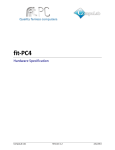
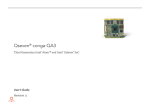

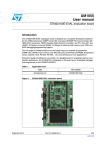
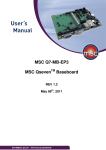
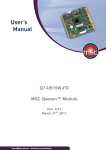
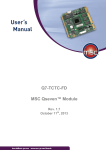

![[S30830T-CPE] Users Manual: CPE83SUE](http://vs1.manualzilla.com/store/data/005890174_1-2a1526c3cbd1c0db150881a0418c3ddc-150x150.png)

